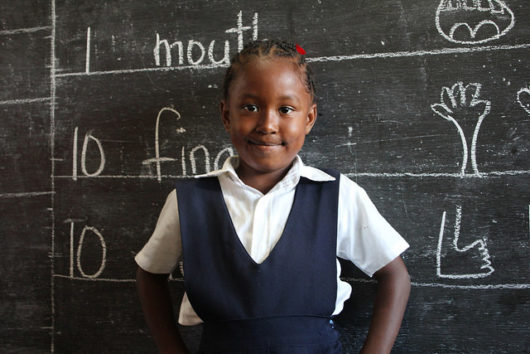10 Facts About Girls’ Education in Guyana

Guyana, a nation located on the Northeastern shoulder of South America, has continually made efforts to improve its education system but the country’s social, political and economic problems have had a devastating effect on it. The lack of funding for education had lead to poor conditions in schools, but Guyana’s government has implemented the Education Sector Plan 2014-2018 in order to improve its education system at all levels. In the text below, 10 facts about girls’ education in Guyana are presented.
10 Facts About Girls’ Education in Guyana
- The gender disparity in education between Guyanese boys and girls continues to grow as they transition into higher grade levels. Girls are outperforming boys in numerous subjects and are more likely to stay in school while boys tend to discontinue. Primary school enrollment for girls was 83 percent, compared to the same figure for boys that was at 95 percent. Secondary school enrollment for girls is 100 percent while it is 96 percent for boys. Primary completion rates for girls is 97 percent and for boys- 98 percent. At the tertiary level, enrollment for girls is twice as high compared to boys.
- In 2013, girls in the coastal areas of Guyana scored 15 to 23 percentage points higher in Math and English than those in the hinterland areas of Guyana. These results are partly due to the higher percentage of poverty and lack of school resources in hinterland areas.
- The teaching profession is seen as the feminization of schooling because women dominate this field. In 2012, 70 percent of secondary education teachers were female and only 27 percent were male. This result is due to tight gender roles in Guyana as girls are seen as more nurturing, open-minded and cooperative. Boys tend to choose non-traditional subjects such as Science and Technology.
- The Ministry’s Labour Department is responsible for creating the National Training Project for Youth Empowerment, which is a 12-week technical and vocational education and training program that targets out-of-school-youth in Guyana. Compared to boys, there was a higher rate of girls that signed up for service occupations such as health services, home economics (623 girls, 8 boys) and IT/Clerical (183 girls, 30 boys).
- First Lady Sarah Granger and Minister of Telecommunications Cathy Hughes have implemented Science, Technology, Engineering and Mathematics (STEM) Guyana that encourages girls to pursue non-traditional careers. They believe that Information Communications Technology (ICT) will provide girls and women with essential skills that will “promote literacy, improve access to health care, and enable the exercise of legal rights and participation in government.” Girls in STEM are the future that will allow Guyana to succeed. Women are a part of present too, as 30 percent of Guyana’s Parliament are female. This percentage of women in Parliament is active since 2005.
- Guyana has one of the highest rates of HIV/AIDS and it is one of two countries that are a part of the United States President’s Emergency Plan for AIDS relief. The knowledge about HIV prevention among young girls aged between 15 and 25 is about 50 percent. For young boys, the knowledge about HIV prevention is 40 percent. Knowledge about safe sex and HIV/AIDS prevention increases with education level for both boys and girls. It is important to educate girls about prevention because girls are more likely to get HIV/AIDS to due biological, socio-cultural and economic reasons. Encouraging girls to stay in school is a way to ensure a better quality of life and an important factor in preventing HIV/AIDS.
- Teenage pregnancy between the ages of 15 and 19 affects 97 out of 1,000 girls in Guyana. The teenage pregnancy rate is the second highest in the Caribbean and South America. Young girls between the ages of 15 and 19 with higher literacy rates have lower adolescent birth rates. Girls who remain in school are less likely to become pregnant.
- The Education Sector Plan (ESP) of 2014-208 was created to provide a quality education for all of Guyana’s citizens. Its main objectives were eliminating illiteracy, strengthening tolerance and modernizing education. The ESP has made huge progress in regards to improving access to education at all levels, increasing the proportion of trained teachers and providing more access to interactive technology, computers and upgrading physical facilities in particular.
- After ESP 2014-2018, students improved 14 percentage points in English but did not improve in Mathematics. ESP is still trying to tackle this lack of progress. ESP was also able to professionally train 70 percent of teachers. It also provided and implemented numerous support programs, including School Health, Nutrition and HIV/AIDS, Health and Family Life Education as well as School Welfare Program.
- Too often, girls are not able to reveal their full potential in improving Guyana’s economy due to discriminatory social norms, incentives and legal institutions. Girls often tend to be overworked, underpaid and sexual harassed in the workplace. A major issue that hinders girls’ education and work is gender-based violence. The World Bank Report of 2017 revealed that only 53 percent of females aged 15-64 participated in Guyana’s labor force compared to 80 percent of males of the same age. This result is the reason why The National Task Force on Prevention of Sexual Violence was established.
Although most of these 10 facts about girls’ education in Guyana shed light on the need for improvement in education, progress is still being achieved. Plans and actions are being supported by the Guyanese government and numerous organizations that are willing to help. Education for both girls and boys is key to improving Guyana as a whole.
– Jocelyn Aguilar
Photo: Flickr
